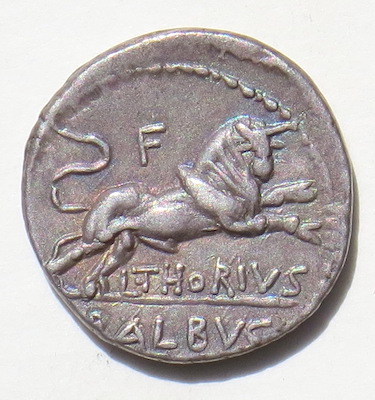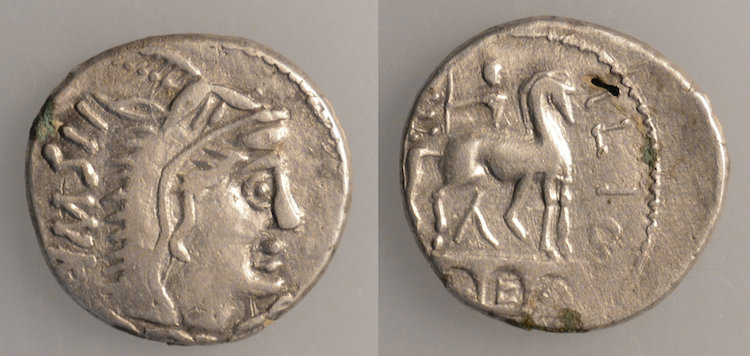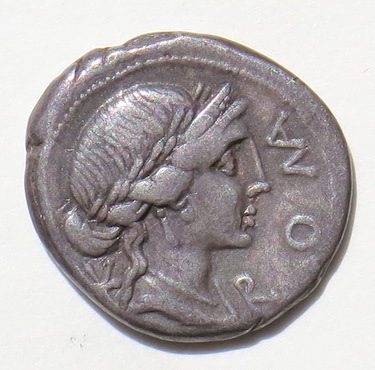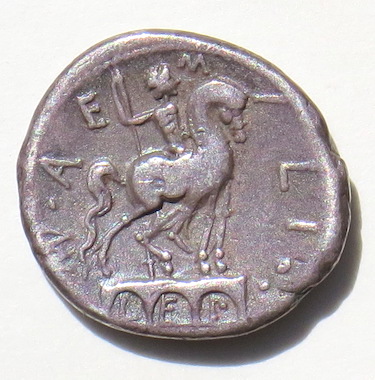Roman Republican plated imitation in Dacian style
Silver coins of the Roman Republic from the first century BC were imitated in good silver in Dacia (north of the Danube, roughly in the region of modern Romania). The artwork is generally crude, although often attractive, and the obverse and reverse types of a single coin are often modeled on different official issues, as opposed to both sides imitating the same coin.
Even imitations were counterfeited. Republican silver denarii and most Dacian imitations were made by striking a blank (a "flan") of nearly pure silver. Counterfeiters could make a profit by, instead, striking a blank with a base copper core wrapped with silver foil. Then the surface would look good but the silver content, on which the value relied, was far less. The second coin below is a plated counterfeit in Dacian style found in southwestern Ukraine which
1) has an obverse of one Republican issue (the first coin)
2) has a reverse of a different Republican issue (the third coin)
3) is a counterfeit with the cavity in front of the horse's head exposing the silver foil
4) and has very light weight (2.90 grams) reconfirming it is counterfeit.
Here is an official issue of the obverse type, followed by the plated counterfeit, followed by an official issue of its reverse type:


Offical issue of 105 BC.
Moneyer: L. Thorius Balbus
18 mm. 3.94 grams.
Head of Juno Sospita right, wearing goat-skin headdress. I S M R behind
Bull charging right
Control mark F above
L THORIVS below
BALBVS in exergue
References: Crawford 316/1. Sear 192
ISMR abbreviates "Juno Sospita Mater Regina"
according to Grueber in CRRBM
 Dacian imitation, fourree
Dacian imitation, fourree
105 BC or later.
18-17 mm. 2.90 grams (low weight)
Obverse as above, crude and blundered
Head of Juno Sospita right, wearing goat-skin headdress. I S M R behind with the "M" upside down
Reverse as below, off center to left
[MV A]E M ILIO around
equestrian statue right, horseman holds spear vertically downwards
horse on triple arch containing L E P
possibly referring to an aqueduct begun in 179 BC by
M. Aemilus Lepidus, an ancestor.
The cavity before the horse's head is hollow
all the way to the foil on the other side (at the base of the goat's horns).


Official issue of 114 or 113 BC.
Mn. Aemilius Lepidus
19-18 mm. 3.81 grams.
Laureate and diademed head of Roma right, ROMA before
MV AE M ILIO around
equestrian statue right, horseman holds spear vertically downwards
horse on triple arch containing L E P
possibly referring to an aqueduct begun in 179 BC by
M. Aemilus Lepidus, an ancestor.
References: Crawford 291/1. Sear 168.
Because the prototype for the obverse is from 105 BC, the Dacian imitation must be from 105 BC or later.
Grueber (CRRBM) says about the first coin, "the rushing bull is a type parlent on the moneyer's name, Thorius" (bull = taurum in Latin), but Crawford is not convinced.
The third coin has an unusual head of Roma, not helmeted, but Crawford thinks it must be Roma because of the clear legend.
The term "hybrid" or "mule" refers to coins with obverses and reverses that are from different issues and should not have been combined on one coin. The Dacian coin above is a hybrid.
The normal Dacian issues are of irregular weights, mostly 3.1-4.6 grams, with some over 4.1 grams up to 4.6 grams. Official Roman coins are rarely that heavy--they were adjusted to weigh about 4.0 grams or less. This one, at 2.90 grams, is too light to be a good-silver imitation.
Phil Davis has a very extensive site on Dacian imitations of Republican denarii: http://rrimitations.ancients.info/
and his collection is was sold in the auction catalog Gemini IX, January 8, 2012, where you can find the prices realized of 185 lots.
This particular coin was found in southwestern Ukraine (north of Hungary, Romania border) in the Carpathian Mountains (2015) in a small hoard of Roman Republic denarii (19 whole, 4-6 partial and damaged), 18 from the Rome mint and 1 an ancient imitation (this one). The terminus post quem for deposition of this hoard is 63 BC (a denarius of Cassius Longinus Vesta/Voter, RRC 413/1). A C. Scribonius denarius of 154 BC (RRC 201/1) is the oldest coin in the hoard.
Return to the main index page of this site.
First posted Dec. 18, 2015
 Dacian imitation, fourree
Dacian imitation, fourree